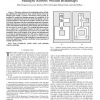Free Online Productivity Tools
i2Speak
i2Symbol
i2OCR
iTex2Img
iWeb2Print
iWeb2Shot
i2Type
iPdf2Split
iPdf2Merge
i2Bopomofo
i2Arabic
i2Style
i2Image
i2PDF
iLatex2Rtf
Sci2ools
TROB
2008
2008
A Complete and Scalable Strategy for Coordinating Multiple Robots Within Roadmaps
Abstract--This paper addresses the challenging problem of finding collision-free trajectories for many robots moving toward individual goals within a common environment. Most popular algorithms for multirobot planning manage the complexity of the problem by planning trajectories for robots individually; such decoupled methods are not guaranteed to find a solution if one exists. In contrast, this paper describes a multiphase approach to the planning problem that uses a graph and spanning tree representation to create and maintain obstacle-free paths through the environment for each robot to reach its goal. The resulting algorithm guarantees a solution for a well-defined number of robots in a common environment. The computational cost is shown to be scalable with complexity linear in the number of the robots, and demonstrated by solving the planning problem for 100 robots, simulated in an
| Added | 15 Dec 2010 |
| Updated | 15 Dec 2010 |
| Type | Journal |
| Year | 2008 |
| Where | TROB |
| Authors | Mike Peasgood, Christopher M. Clark, John McPhee |
Comments (0)

